Experimental and Kinetic Studies on the Conversion of Glucose to Levulinic Acid Catalyzed by Synergistic Cr/HZSM-5 in GVL/H2O Biphasic System
Abstract
1. Introduction
2. Results and Discussion
2.1. Catalyst Characterization
2.2. Activity Comparison of HZSM-5 Catalyst with Different Cr Loading Ratios
2.3. Influence of Reaction Conditions on Catalytic Performance
2.4. Effect of Different Co-Solvents on the Conversion of Glucose
2.5. Effect of Different GVL Contents in Solvent Systems on the Conversion of Glucose
2.6. Kinetic Study of the Response of GVL to Glucose to LA
2.7. MD Simulation Analysis of Glucose to LA Under Solvent Action
2.8. Catalyst Reusability
3. Experimental
3.1. Materials
3.2. Catalyst Preparation
3.3. Catalytic Reactions
3.4. Analytical Characterization
3.5. Characterization Test
3.6. Molecular Dynamics Simulation
4. Conclusions
Supplementary Materials
Author Contributions
Funding
Data Availability Statement
Acknowledgments
Conflicts of Interest
References
- Guo, Z.; Pedersen, C.M.; Wang, P.; Ma, M.; Zhao, Y.; Qiao, Y.; Wang, Y. D-Glucose isomerization with PAMAM dendrimers as environmentally friendly catalysts. J. Agric. Food Chem. 2021, 69, 5105–5112. [Google Scholar] [CrossRef] [PubMed]
- Mongkolpichayarak, I.; Jiraroj, D.; Anutrasakda, W.; Ngamcharussrivichai, C.; Samec, J.S.; Tungasmita, D.N. Cr/MCM-22 catalyst for the synthesis of levulinic acid from green hydrothermolysis of renewable biomass resources. J. Catal. 2022, 405, 373–384. [Google Scholar] [CrossRef]
- Zhang, T.; Tang, Y.; Guo, S.; Cao, X.; Pan, A.; Fang, G.; Zhou, J.; Liang, S. Fundamentals and perspectives in developing zinc-ion battery electrolytes: A comprehensive review. Energy Environ. Sci. 2020, 13, 4625–4665. [Google Scholar] [CrossRef]
- Shen, F.; Sun, S.; Zhang, X.; Yang, J.; Qiu, M.; Qi, X. Mechanochemical-assisted production of 5-hydroxymethylfurfural from high concentration of cellulose. Cellulose 2020, 27, 3013–3023. [Google Scholar] [CrossRef]
- Dutta, S.; De, S.; Alam, M.I.; Abu-Omar, M.M.; Saha, B. Direct conversion of cellulose and lignocellulosic biomass into chemicals and biofuel with metal chloride catalysts. J. Catal. 2012, 288, 8–15. [Google Scholar] [CrossRef]
- Hu, W.; Chi, Z.; Wan, Y.; Wang, S.; Lin, J.; Wan, S.; Wang, Y. Synergetic effect of Lewis acid and base in modified Sn-β on the direct conversion of levoglucosan to lactic acid. Catal. Sci. Technol. 2020, 10, 2986–2993. [Google Scholar] [CrossRef]
- Intaramas, K.; Jonglertjunya, W.; Laosiripojana, N.; Sakdaronnarong, C. Selective conversion of cassava mash to glucose using solid acid catalysts by sequential solid state mixed-milling reaction and thermo-hydrolysis. Energy 2018, 149, 837–847. [Google Scholar] [CrossRef]
- Chauhan, A.; Bal, R.; Srivastava, R. Synthesis of γ-Valerolactone from Levulinic Acid with Co/NC, and from Furfural via Cascade Reaction Using Co/NC and H-Beta. Energy Fuels 2024, 38, 5998–6011. [Google Scholar] [CrossRef]
- Gu, C.; Chen, L.; Liu, Y.; Zhang, X.; Liu, J.; Zhang, Q.; Wang, C.; Ma, L. One-pot conversion of biomass-derived levulinic acid to furanic biofuel 2-methyltetrahydrofuran over bimetallic NiCo/γ-Al2O3 catalysts. Mol. Catal. 2022, 524, 112317. [Google Scholar] [CrossRef]
- Tyagi, U.; Anand, N.; Kumar, D. Synergistic effect of modified activated carbon and ionic liquid in the conversion of microcrystalline cellulose to 5-Hydroxymethyl Furfural. Bioresour. Technol. 2018, 267, 326–332. [Google Scholar] [CrossRef] [PubMed]
- Hak, C.; Panchai, P.; Nutongkaew, T.; Grisdanurak, N.; Tulaphol, S. One-pot levulinic acid production from rice straw by acid hydrolysis in deep eutectic solvent. Chem. Eng. Commun. 2024, 211, 366–378. [Google Scholar] [CrossRef]
- Kumar, K.; Parveen, F.; Patra, T.; Upadhyayula, S. Hydrothermal conversion of glucose to levulinic acid using multifunctional ionic liquids: Effects of metal ion co-catalysts on the product yield. New J. Chem. 2018, 42, 228–236. [Google Scholar] [CrossRef]
- Xu, X.; Liang, B.; Zhu, Y.; Chen, J.; Gan, T.; Hu, H.; Zhang, Y.; Huang, Z.; Qin, Y. Direct and efficient conversion of cellulose to levulinic acid catalyzed by carbon foam-supported heteropolyacid with Brønsted–Lewis dual-acidic sites. Bioresour. Technol. 2023, 387, 129600. [Google Scholar] [CrossRef] [PubMed]
- Ya’aini, N.; Amin, N.A.S.; Endud, S. Characterization and performance of hybrid catalysts for levulinic acid production from glucose. Microporous Mesoporous Mater. 2013, 171, 14–23. [Google Scholar] [CrossRef]
- Chu, S.; Guo, X.; Dong, L.; Chen, X.; Li, Y.; Mu, X. The influence of pore structure and Si/Al ratio of HZSM-5 zeolites on the product distributions of α-cellulose hydrolysis. Mol. Catal. 2018, 445, 240–247. [Google Scholar] [CrossRef]
- Bounoukta, C.E.; Megías-Sayago, C.; Ivanova, S.; Ammari, F.; Centeno, M.A.; Odriozola, J.A. Pursuing efficient systems for glucose transformation to levulinic acid: Homogeneous vs. heterogeneous catalysts and the effect of their co-action. Fuel 2022, 318, 123712. [Google Scholar] [CrossRef]
- Pidko, E.A.; Degirmenci, V.; van Santen, R.A.; Hensen, E. Glucose activation by transient Cr2+ dimers. Angew Chem 2010, 49, 2530–2534. [Google Scholar] [CrossRef] [PubMed]
- Yang, S.; He, D.; Zhang, L.; Zhang, Y.; Lu, J.; Luo, Y. Toxic chromium treatment induce amino-assisted electrostatic adsorption for the synthesis of highly dispersed chromium catalyst. J. Hazard. Mater. 2021, 417, 126155. [Google Scholar] [CrossRef]
- Ayari, F.; Mhamdi, M.; Álvarez-Rodríguez, J.; Ruiz, A.G.; Delahay, G.; Ghorbel, A. Selective catalytic reduction of NO with NH3 over Cr-ZSM-5 catalysts: General characterization and catalysts screening. Appl. Catal. B Environ. 2013, 134, 367–380. [Google Scholar] [CrossRef]
- Figueiredo, H.; Silva, B.; Quintelas, C.; Raposo, M.; Parpot, P.; Fonseca, A.; Lewandowska, A.; Bañares, M.; Neves, I.; Tavares, T. Immobilization of chromium complexes in zeolite Y obtained from biosorbents: Synthesis, characterization and catalytic behaviour. Appl. Catal. B Environ. 2010, 94, 1–7. [Google Scholar] [CrossRef][Green Version]
- Kułażyński, M.; Van Ommen, J.; Trawczyński, J.; Walendziewski, J. Catalytic combustion of trichloroethylene over TiO2-SiO2 supported catalysts. Appl. Catal. B Environ. 2002, 36, 239–247. [Google Scholar] [CrossRef]
- Raguindin, R.Q.; Desalegn, B.Z.; Gebresillase, M.N.; Seo, J.G. Yolk-shell nickel–cobalt phosphides as bifunctional catalysts in the solvent-free hydrogenation of Levulinic acid to gamma-Valerolactone. Renew. Energy 2022, 191, 763–774. [Google Scholar] [CrossRef]
- Mellmer, M.A.; Sanpitakseree, C.; Demir, B.; Ma, K.; Elliott, W.A.; Bai, P.; Johnson, R.L.; Walker, T.W.; Shanks, B.H.; Rioux, R.M. Effects of chloride ions in acid-catalyzed biomass dehydration reactions in polar aprotic solvents. Nat. Commun. 2019, 10, 1132. [Google Scholar] [CrossRef]
- Mthembu, L.D.; Gupta, R.; Dziike, F.; Lokhat, D.; Deenadayalu, N. Conversion of Biomass-Derived Levulinic Acid into γ-Valerolactone Using Methanesulfonic Acid: An Optimization Study Using Response Surface Methodology. Fermentation 2023, 9, 288. [Google Scholar] [CrossRef]
- Xu, R.; Liu, K.; Du, H.; Liu, H.; Cao, X.; Zhao, X.; Qu, G.; Li, X.; Li, B.; Si, C. Falling leaves return to their roots: A review on the preparation of γ-valerolactone from lignocellulose and its application in the conversion of lignocellulose. ChemSusChem 2020, 13, 6461–6476. [Google Scholar] [CrossRef] [PubMed]
- Song, B.; Yu, Y.; Wu, H. Tuning glucose decomposition in hot-compressed gamma-valerolactone/water mixtures: From isomerization to dehydration reactions. Fuel 2019, 238, 225–231. [Google Scholar] [CrossRef]
- Wu, H.; Zhang, R.; Zhai, Y.; Song, X.; Xiong, J.; Li, X.; Qiao, Y.; Lu, X.; Yu, Z. Solvent Effects Enable Efficient Tandem Conversion of Cellulose and Its Monosaccharides Towards 5-Hydroxymethylfurfural. ChemSusChem 2023, 16, e202201809. [Google Scholar] [CrossRef] [PubMed]
- Li, X.; Liu, Q.; Si, C.; Lu, L.; Luo, C.; Gu, X.; Liu, W.; Lu, X. Green and efficient production of furfural from corn cob over H-ZSM-5 using γ-valerolactone as solvent. Ind. Crops Prod. 2018, 120, 343–350. [Google Scholar] [CrossRef]
- Chen, H.; Chen, L.; Lin, J.; Tan, K.; Li, J. Copper sites in copper-exchanged ZSM-5 for CO activation and methanol synthesis: XPS and FTIR studies. Inorg. Chem. 1997, 36, 1417–1423. [Google Scholar] [CrossRef]
- Pu, H.; Han, C.; Wang, H.; Xu, S.; Zhang, L.; Zhang, Y.; Luo, Y. Characterization and investigation mechanism of hydrothermal stability for micropore-free ordered mesoporous molecular sieves. Appl. Surf. Sci. 2012, 258, 8895–8901. [Google Scholar] [CrossRef]
- Cihanoğlu, A.; Gündüz, G.; Dükkancı, M. Degradation of acetic acid by heterogeneous Fenton-like oxidation over iron-containing ZSM-5 zeolites. Appl. Catal. B Environ. 2015, 165, 687–699. [Google Scholar] [CrossRef]
- Luan, P.; Chen, J.; Liu, T.; Wang, J.; Yan, B.; Li, N.; Cui, X.; Chen, G.; Cheng, Z. Ex-situ catalytic fast pyrolysis of waste polycarbonate for aromatic hydrocarbons: Utilizing HZSM-5/modified HZSM-5. J. Anal. Appl. Pyrolysis 2024, 182, 106667. [Google Scholar] [CrossRef]
- Mushrif, S.H.; Varghese, J.J.; Vlachos, D.G. Insights into the Cr (III) catalyzed isomerization mechanism of glucose to fructose in the presence of water using ab initio molecular dynamics. Phys. Chem. Chem. Phys. 2014, 16, 19564–19572. [Google Scholar] [CrossRef]
- Choudhary, V.; Mushrif, S.H.; Ho, C.; Anderko, A.; Nikolakis, V.; Marinkovic, N.S.; Frenkel, A.I.; Sandler, S.I.; Vlachos, D.G. Insights into the interplay of Lewis and Brønsted acid catalysts in glucose and fructose conversion to 5-(hydroxymethyl) furfural and levulinic acid in aqueous media. J. Am. Chem. Soc. 2013, 135, 3997–4006. [Google Scholar] [CrossRef]
- Taghavi, S.; Ghedini, E.; Menegazzo, F.; Giordana, A.; Cerrato, G.; Cruciani, G.; Di Michele, A.; Zendehdel, M.; Signoretto, M. Balanced acidity by microwave-assisted ion-exchange of ZSM-5 zeolite as a catalyst for transformation of glucose to levulinic acid. Biomass Convers. Biorefinery 2024, 14, 8251–8269. [Google Scholar] [CrossRef]
- Hu, L.; Wu, Z.; Xu, J.; Sun, Y.; Lin, L.; Liu, S. Zeolite-promoted transformation of glucose into 5-hydroxymethylfurfural in ionic liquid. Chem. Eng. J. 2014, 244, 137–144. [Google Scholar] [CrossRef]
- Teong, S.P.; Yi, G.; Cao, X.; Zhang, Y. Poly-benzylic ammonium chloride resins as solid catalysts for fructose dehydration. ChemSusChem 2014, 7, 2120–2124. [Google Scholar] [CrossRef]
- Shi, N.; Liu, Q.; Ju, R.; He, X.; Zhang, Y.; Tang, S.; Ma, L. Condensation of α-carbonyl aldehydes leads to the formation of solid humins during the hydrothermal degradation of carbohydrates. Acs Omega 2019, 4, 7330–7343. [Google Scholar] [CrossRef] [PubMed]
- Ghosh, M.K.; Howard, M.S.; Dussan, K.; Dooley, S. Mechanism and theory of d-glucopyranose homogeneous acid catalysis in the aqueous solution phase. Phys. Chem. Chem. Phys. 2019, 21, 17993–18011. [Google Scholar] [CrossRef] [PubMed]
- Guo, H.; Duereh, A.; Su, Y.; Hensen, E.J.; Qi, X.; Smith Jr, R.L. Mechanistic role of protonated polar additives in ethanol for selective transformation of biomass-related compounds. Appl. Catal. B Environ. 2020, 264, 118509. [Google Scholar] [CrossRef]
- Antonetti, C.; Fulignati, S.; Licursi, D.; Raspolli Galletti, A.M. Turning point toward the sustainable production of 5-hydroxymethyl-2-furaldehyde in water: Metal salts for its synthesis from fructose and inulin. ACS Sustain. Chem. Eng. 2019, 7, 6830–6838. [Google Scholar] [CrossRef]
- Vasudevan, V.; Mushrif, S.H. Insights into the solvation of glucose in water, dimethyl sulfoxide (DMSO), tetrahydrofuran (THF) and N, N-dimethylformamide (DMF) and its possible implications on the conversion of glucose to platform chemicals. Rsc Adv. 2015, 5, 20756–20763. [Google Scholar] [CrossRef]
- Abraham, M.J.; Murtola, T.; Schulz, R.; Páll, S.; Smith, J.C.; Hess, B.; Lindahl, E. GROMACS: High performance molecular simulations through multi-level parallelism from laptops to supercomputers. SoftwareX 2015, 1, 19–25. [Google Scholar] [CrossRef]

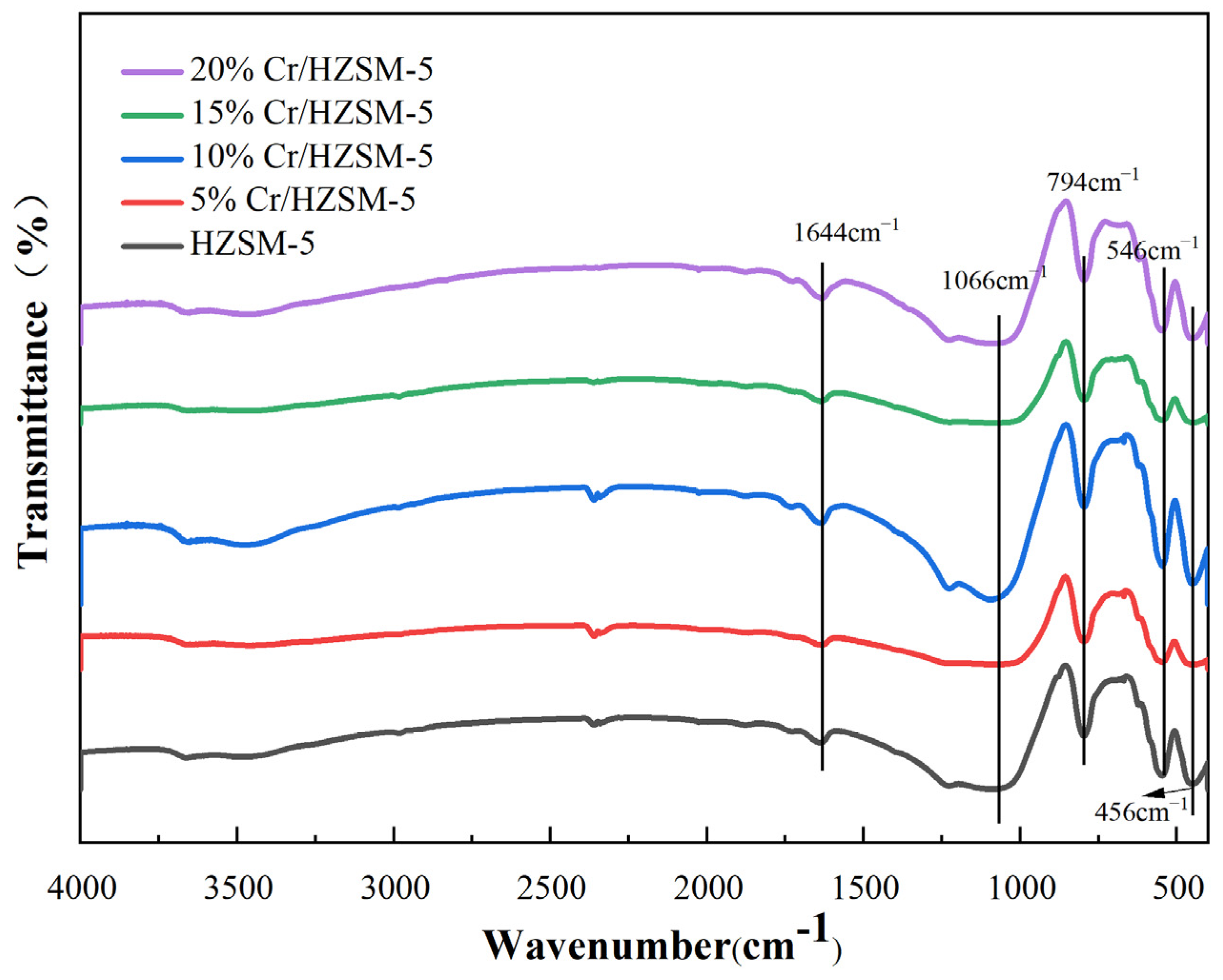
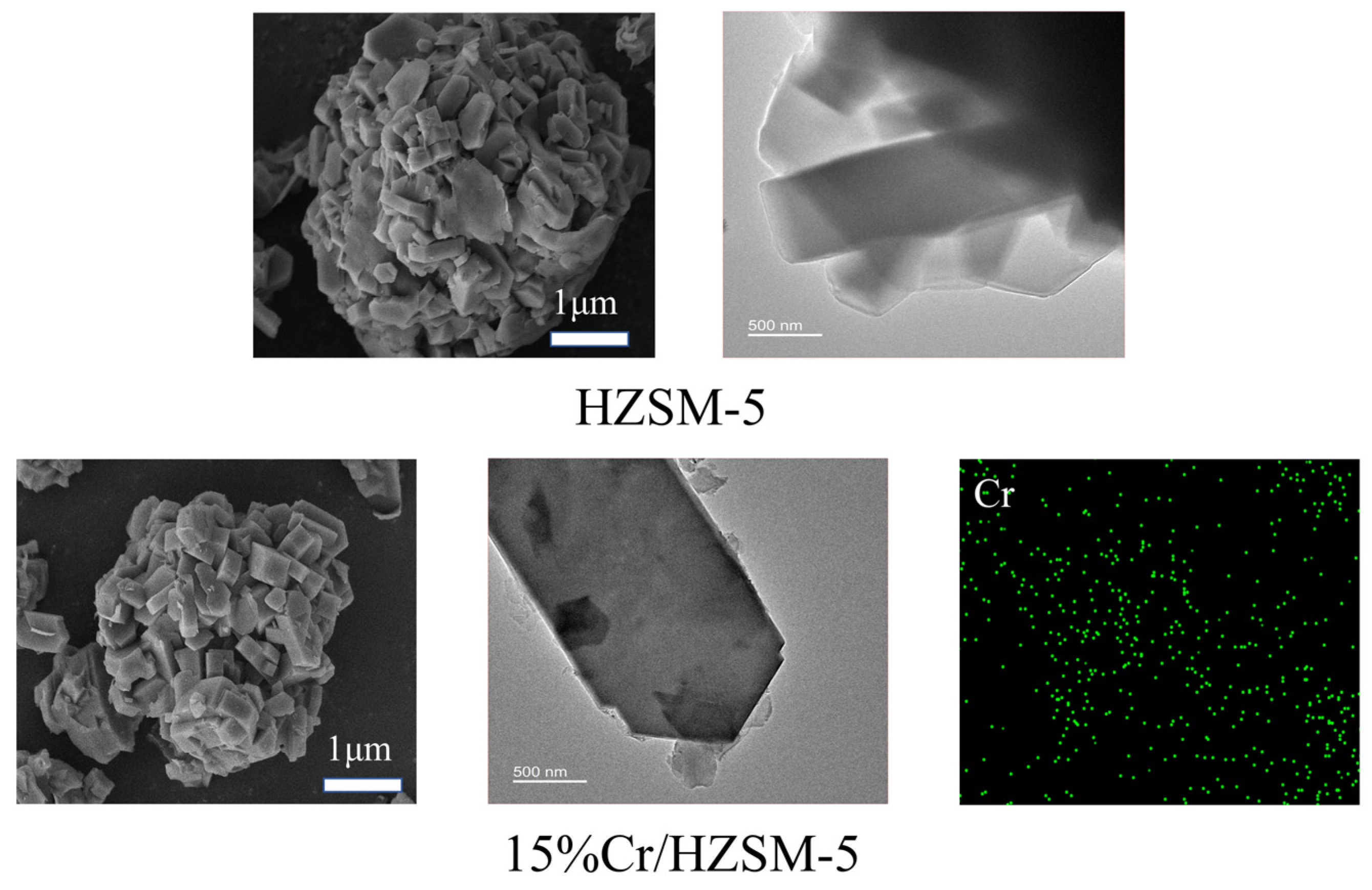
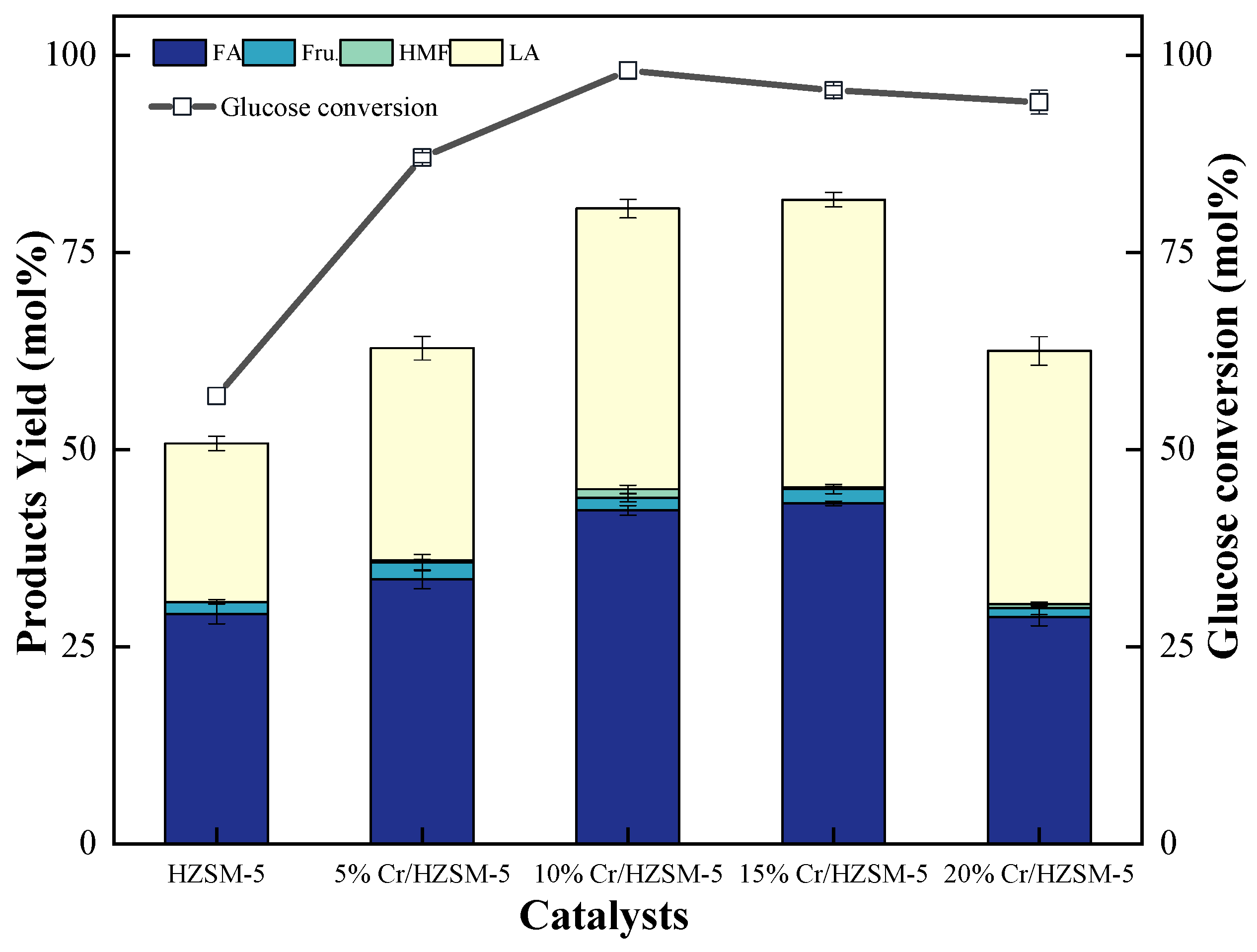

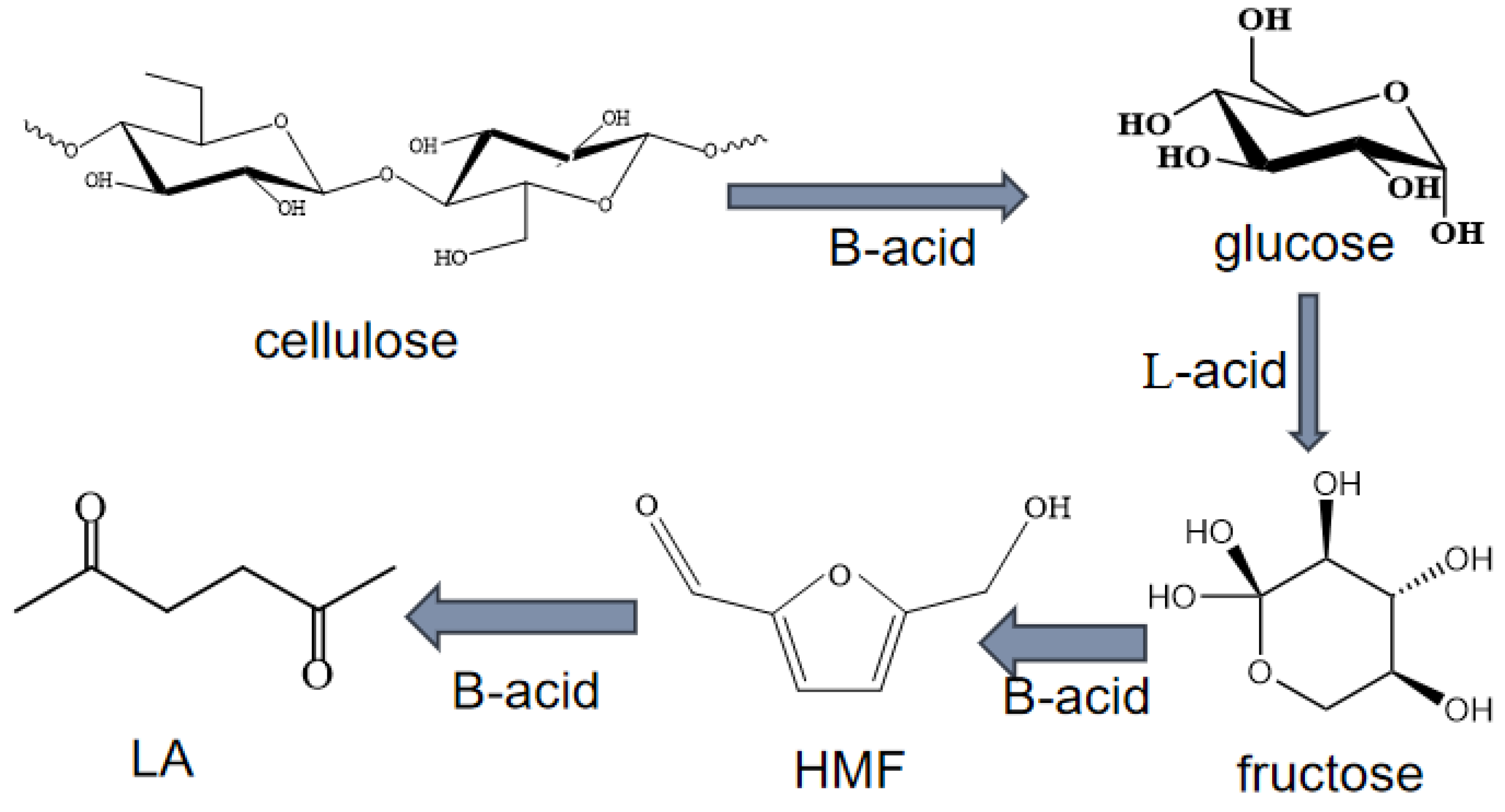




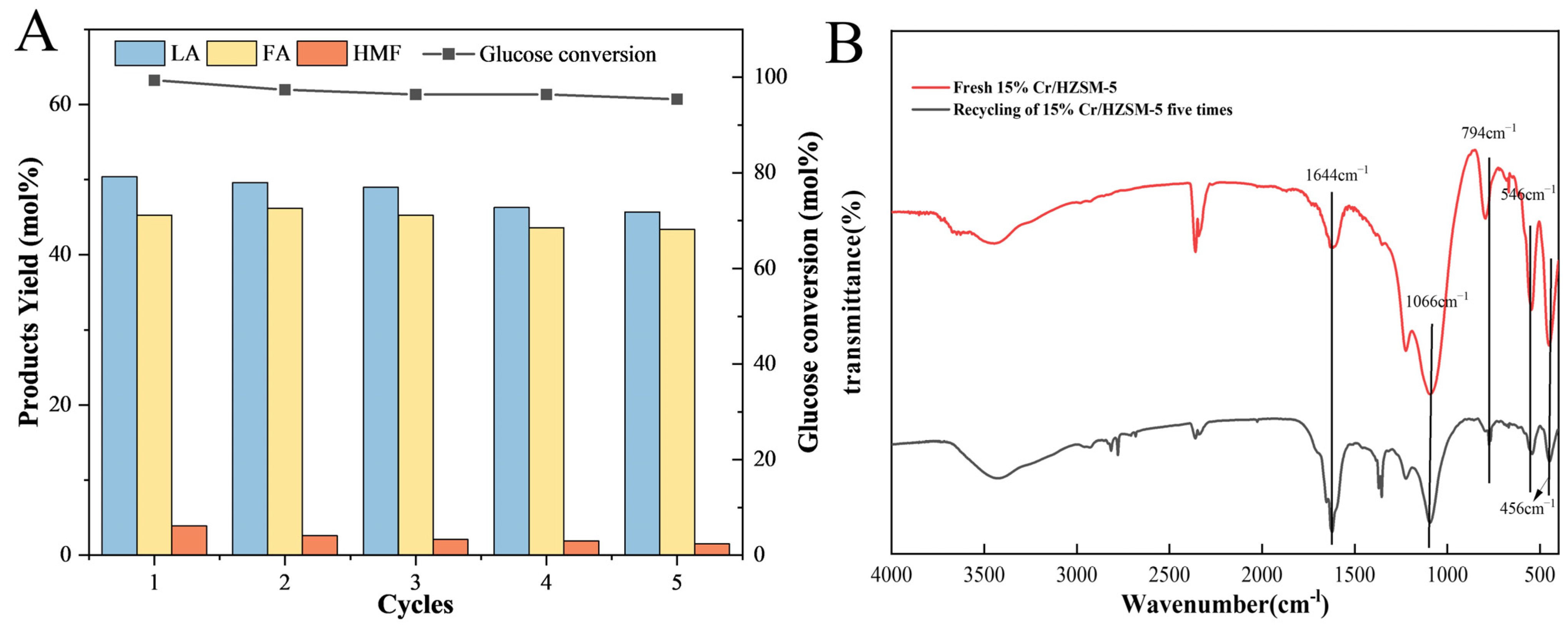
| Catalysts | Cr (wt%) | Surface Area (m2/g) | Pore Size (nm) | Weak Acidity Amount (mmol/g) | Moderate Acidity Amount (mmol/g) | Total Acidity (mmol/g) |
|---|---|---|---|---|---|---|
| HZSM-5 | - | 266 | 5.11 | 0.89 | 0.76 | 1.650 |
| 5% Cr/HZSM-5 | 0.97 | 262 | 5.16 | 2.813 | 1.154 | 3.967 |
| 10% Cr/HZSM-5 | 1.65 | 246 | 4.97 | 2.946 | 1.398 | 4.344 |
| 15% Cr/HZSM-5 | 2.48 | 231 | 3.50 | 2.994 | 1.581 | 4.575 |
| 20% Cr/HZSM-5 | 3.09 | 190 | 1.87 | 3.223 | 1.553 | 4.776 |
| Solvent Systems | Tem. (°C) | Glucose Dehydration KG | R2 | Ea (kJ/mol) | HMF Rehydration KH | R2 | Ea (kJ/mol) |
|---|---|---|---|---|---|---|---|
| H2O | 160 | 0.09578 | 0.96322 | 59.19 | 0.07813 | 0.95625 | 52.62 |
| 180 | 0.20125 | 0.94285 | 0.15054 | 0.96437 | |||
| 200 | 0.38468 | 0.97468 | 0.26869 | 0.99518 | |||
| 20%GVL/H2O | 160 | 0.11245 | 0.9788 | 27.02 | 0.08351 | 0.99087 | 26.27 |
| 180 | 0.13284 | 0.94533 | 0.13683 | 0.91705 | |||
| 200 | 0.21312 | 0.97582 | 0.15417 | 0.98887 |
Disclaimer/Publisher’s Note: The statements, opinions and data contained in all publications are solely those of the individual author(s) and contributor(s) and not of MDPI and/or the editor(s). MDPI and/or the editor(s) disclaim responsibility for any injury to people or property resulting from any ideas, methods, instructions or products referred to in the content. |
© 2025 by the authors. Licensee MDPI, Basel, Switzerland. This article is an open access article distributed under the terms and conditions of the Creative Commons Attribution (CC BY) license (https://creativecommons.org/licenses/by/4.0/).
Share and Cite
Wu, H.; Zhang, R.; Li, J.; Chang, J.; Liu, Z.; Chen, J.; Xiong, J.; Qiao, Y.; Yu, Z.; Lu, X. Experimental and Kinetic Studies on the Conversion of Glucose to Levulinic Acid Catalyzed by Synergistic Cr/HZSM-5 in GVL/H2O Biphasic System. Catalysts 2025, 15, 162. https://doi.org/10.3390/catal15020162
Wu H, Zhang R, Li J, Chang J, Liu Z, Chen J, Xiong J, Qiao Y, Yu Z, Lu X. Experimental and Kinetic Studies on the Conversion of Glucose to Levulinic Acid Catalyzed by Synergistic Cr/HZSM-5 in GVL/H2O Biphasic System. Catalysts. 2025; 15(2):162. https://doi.org/10.3390/catal15020162
Chicago/Turabian StyleWu, Han, Rui Zhang, Jiantao Li, Jing Chang, Zhihua Liu, Jiale Chen, Jian Xiong, Yina Qiao, Zhihao Yu, and Xuebin Lu. 2025. "Experimental and Kinetic Studies on the Conversion of Glucose to Levulinic Acid Catalyzed by Synergistic Cr/HZSM-5 in GVL/H2O Biphasic System" Catalysts 15, no. 2: 162. https://doi.org/10.3390/catal15020162
APA StyleWu, H., Zhang, R., Li, J., Chang, J., Liu, Z., Chen, J., Xiong, J., Qiao, Y., Yu, Z., & Lu, X. (2025). Experimental and Kinetic Studies on the Conversion of Glucose to Levulinic Acid Catalyzed by Synergistic Cr/HZSM-5 in GVL/H2O Biphasic System. Catalysts, 15(2), 162. https://doi.org/10.3390/catal15020162







